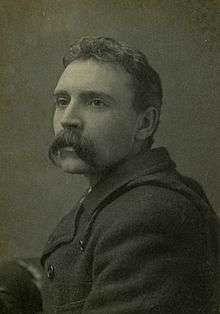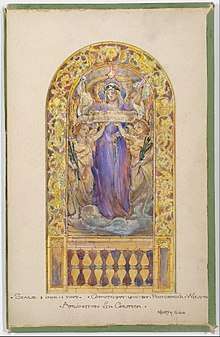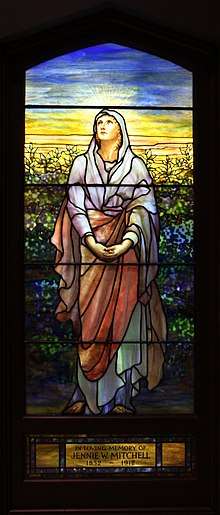Frederick Wilson (artist)
Frederick Wilson (3 November 1858 - 24 March 1932) was a British stained glass artist best known for his work with Tiffany Studios. He was a prominent designer of ecclesiastical windows in the United States during the late 19th and early 20th centuries.[1][2]
Frederick Wilson | |
|---|---|
 Frederick Wilson circa 1891 | |
| Born | November 3, 1858 |
| Died | March 24, 1932 (aged 74) |
| Nationality | British |
| Known for | stained glass, mosaic |
| Spouse(s) | Mary Gwladys Morgan (1891-1932; his death) |
Biography
Frederick Wilson was born in Dublin, Ireland to English parents, Charles and Elizabeth Wilson. The family eventually moved to England and Wilson and his six siblings were raised in both Liverpool and London.[3] Although little is known about Wilson's early artistic education, there is evidence that he attended the South Kensington School, which was associated with the South Kensington Museum (now known as the Victoria and Albert Museum).[3]
In 1891, Wilson married Mary Gwladys Morgan, and the following year they immigrated to the United States. The couple had three children: Gladys, Sylvia and Beatrice.
Career

Frederick Wilson's career designing stained glass spanned more than 50 years. He was "known and accepted as an important artist in his field" during his lifetime, and his work had a major impact on how American ecclesiastical stained glass looked around the turn of the 20th century.[3]
Perhaps best known for his work at Tiffany Studios, Wilson also designed windows for at least five other firms, including: Heaton, Butler and Bayne, London, England; Alfred Godwin and Company, Philadelphia, Pennsylvania; Gorham Manufacturing Company, Providence, Rhode Island; The Los Angeles Art Glass Company, Los Angeles, California; and Judson Studios, also in Los Angeles.[3]
Over the course of his career, Wilson was a member of several professional arts groups, including the Art Club of Philadelphia, the Pennsylvania Academy of the Fine Arts, the American Federation of Arts, and the Architectural League of New York.[3]
Wilson likely began his artistic career in England in the 1870s. He was heavily influenced by the work of the Pre-Raphaelites, and incorporated ecclesiastical subjects in his designs from a young age.[3]
In 1892, Wilson and his wife Mary emigrated to the United States. He soon found employment at Alfred Godwin and Company in Philadelphia. However there are no known Wilson designs executed by the company, and by 1893 he began working for Tiffany Studios.[3]
Tiffany Studios and later career
Wilson was among the most prominent and prolific designers at Tiffany Studios, and was the first in-house designer in the Ecclesiastical Department.[4][5] He likely joined the firm sometime in 1893, and that same year exhibited one of his designs using Tiffany's name at the World's Columbian Exposition in Chicago, Illinois. Wilson was awarded a gold medal for work under his own name at the Exposition Universelle in Paris, France in 1900.[6]
In 1897, Wilson became Tiffany Studio's chief window designer.[7] Two years later, in 1899, he was appointed the head of the Ecclesiastical Department.[8] During this time he maintained his own studio in Briarcliff Manor, New York, and would often work there instead of at the Tiffany Studios factory in Corona, Queens.
Wilson left Tiffany Studios in 1923.[7] He moved to Los Angeles to work for Judson Studios. There, he received commissions for his work across the state, including a commission from the Judson family themselves on the death of William Lees Judson, the founder of the College of Fine Arts of the University of Southern California and the father of Judson Studios founder, Walter Judson.[3][9]
Wilson's final commission was for a series of windows to be installed in Garrett Memorial Chapel in, Jerusalem, New York. He completed the designs for the windows in 1931, but did not live to see their installation in 1932.[10]
Wilson passed away in March 1932 in Los Angeles.
Selected works

- Windows in the Naval Academy Chapel (1899-1920), Annapolis, Maryland. Wilson designed a number of memorial windows for the chapel, including The Mason Window (1899), the Porter Window (1908), the Sampson Window (1909), and the Farragut Window (1920).[11][12]
- The Righteous Shall Receive a Crown of Glory (1901), originally installed in the United Methodist Church in Waterville, New York. This window was commissioned by Ira and Mary Brainard in memory of Charles Green. It is now in the collection of the Corning Museum of Glass.[5]
- The Te Deum (1906), originally installed in First Presbyterian Church, Syracuse, New York.[3] The windows were likely removed around 2008 when the church was purchased by a Tiffany dealer.[13]
- Good Shepherd and Landscape (1909), originally installed the Stony Wold Sanatorium chapel in Lake Kushaqua, New York. The window was donated by Mrs. Walter Geer to Stony Wold in memory of her sister, Miss Martha Potter.[14] It is now divided between the collections of the New-York Historical Society and the Neustadt.
- The Prayer of the Christian Soldier (1919), installed in First Presbyterian Church (now United Presbyterian Church) in Binghamton, New York. [15]
- Anselm and Wycliff, (1920s) Saint John's Chapel at the Episcopal Divinity School, Cambridge, Massachusetts.[3]
- Windows in the Garrett Memorial Chapel (1930-31), Jerusalem, New York. These were the last windows designed by Wilson before his death. [10]
See also
References
- Frelinghuysen, Alice Cooney (Summer 1998). "Louis Comfort Tiffany at the Metropolitan Museum". The Metropolitan Museum of Art Bulletin: 31.
- "Overview and Highlights". The Neustadt. The Neustadt. Retrieved 22 March 2018.
- Wright, Diane C. (2009). "Frederick Wilson: 50 Years of Stained Glass Design". Journal of Glass Studies. 51: 198.
- "Tiffany Studios". The Charles Hosmer Morse Museum of American Art. Charles Hosmer Morse Foundation, Inc. Retrieved 22 March 2018.
- "Two Important Examples of Tiffany Studios Glass Go on View at The Corning Museum of Glass". Corning Museum of Glass. Corning Museum of Glass. 4 April 2013. Retrieved 22 March 2018.
- Report of the Commissioner-general for the United States to the International Universal Exposition, Paris, 1900: Volume 3. U.S. Government Printing Office. 1901. p. 89. Retrieved 22 March 2018.
- Duncan, Alastair (1992). Louis Comfort Tiffany. New York: Abrams. p. 81. ISBN 9780810938625.
- "What are the Tiffany Windows?". Virginia Museum of Fine Arts. Virginia Museum of Fine Arts. Retrieved 22 March 2018.
- "Judson Studios: Artisanal Stained Glass". KCET. KCETLink. 17 October 2011. Retrieved 22 March 2018.
- "About Us". Garrett Memorial Chapel. Garrett Chapel Trust. Retrieved 22 March 2018.
- "Stained Glass". Annapolis, MD. City of Annapolis. Archived from the original on 23 March 2018. Retrieved 22 March 2018.
- Huston, Vince (7 March 2013). "Chapel stained glass windows". Retrieved 22 March 2018.
- Knauss, Tim (26 February 2013). "With Tiffany windows gone, South Presbyterian Church symbolizes fears of Syracuse preservationists". syracuse.com. Advance Media New York. Retrieved 22 March 2018.
- "Current Long-Term Loans: Good Shepherd and Landscape, 1909 The New-York Historical Society". The Neustadt. The Neustadt. Retrieved 22 March 2018.
- Michel, Karen (3 August 2017). "Tiffany Is Known For Lamps And Stained Glass, But He Made Magical Mosaics, Too". NPR. NPR. Retrieved 22 March 2018.
External links
| Wikimedia Commons has media related to Frederick Wilson. |
- Jeffrey Rush Higgins Collection on Frederick Wilson, 1885-1990, Rakow Research Library, The Corning Museum of Glass, Corning, NY. (Retrieved 3 March 2016)
- Judson Studios Photograph Collection of Frederick Wilson Design Drawings, 1895 to 1932, Rakow Research Library, The Corning Museum of Glass, Corning, NY. (Retrieved 3 March 2016)
- Frederick Wilson materials at the Metropolitan Museum of Art, Metropolitan Museum of Art, New York, NY. (Retrieved 22 March 2018)